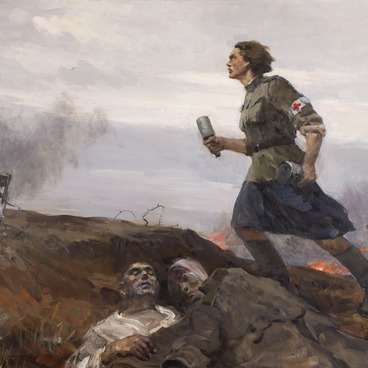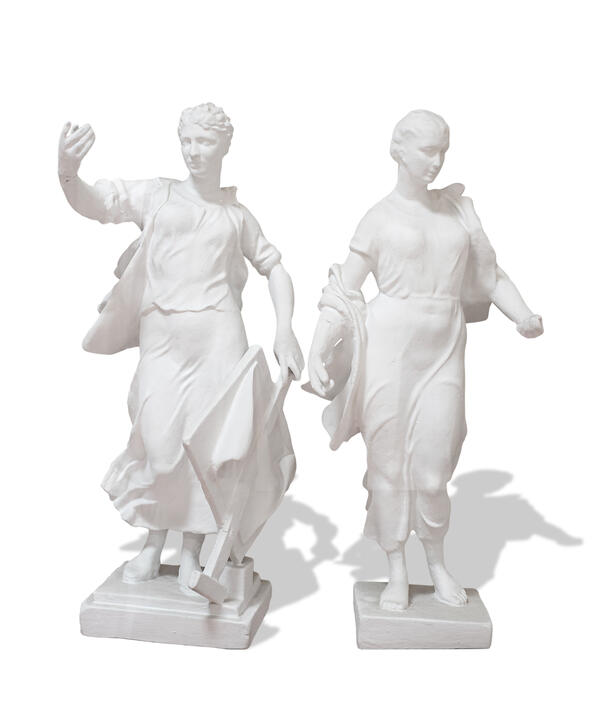Vera Mukhina became a member of the USSR Academy of Arts in 1947, eleven years after she created the famous monument “Worker and Kolkhoz Woman”. The same year she completed the posthumous bust of Nikolay Burdenko.
Nikolay Burdenko, a surgeon, academician, and colonel general of the Medical Corps, was born on May 22, 1876, in the village of Kamenka near Penza. Son of a churchman, Nikolay was destined to follow in the footsteps of his father. He studied at the Penza Theological School and graduated from the Penza Seminary. To complete his studies, he applied to the Saint Petersburg Theological Academy.
However, Nikolay never showed up in class. He surprised everyone by entering the Medical School at Tomsk University. From that moment on, surgery became his only interest. Nikolay Burdenko completed his studies at the University of Yuryev (now Tartu), where he went after being expelled because of his involvement in revolutionary activities. This university was the alma mater of Nikolay Pirogov, a role model for Burdenko.
Having started his career as a junior doctor, Nikolay Burdenko went on to become a top public health official. He took part in four wars. It was during the Russo-Japanese War that Burdenko already noticed how poorly the provision of medical services was organized in the army.
With the start of World War I, Nikolay Burdenko volunteered for frontline duty and worked to improve the quality of healthcare services. He took the initiative to establish medical brigades that helped the wounded fight pain-induced shock. Under his supervision, over twenty-five thousand wounded were evacuated to the rear.
During the Great Patriotic War, Burdenko was appointed Chief Surgeon of the Red Army. He visited frontline hospitals to collect information and test the effects of antibiotics. Having survived two cerebral hemorrhages, he did not abandon his work and participated in the organization of medical services until the end of the war.
Nikolay Burdenko died on November 11, 1946. Shortly before that, he wrote in his diary,
Nikolay Burdenko, a surgeon, academician, and colonel general of the Medical Corps, was born on May 22, 1876, in the village of Kamenka near Penza. Son of a churchman, Nikolay was destined to follow in the footsteps of his father. He studied at the Penza Theological School and graduated from the Penza Seminary. To complete his studies, he applied to the Saint Petersburg Theological Academy.
However, Nikolay never showed up in class. He surprised everyone by entering the Medical School at Tomsk University. From that moment on, surgery became his only interest. Nikolay Burdenko completed his studies at the University of Yuryev (now Tartu), where he went after being expelled because of his involvement in revolutionary activities. This university was the alma mater of Nikolay Pirogov, a role model for Burdenko.
Having started his career as a junior doctor, Nikolay Burdenko went on to become a top public health official. He took part in four wars. It was during the Russo-Japanese War that Burdenko already noticed how poorly the provision of medical services was organized in the army.
With the start of World War I, Nikolay Burdenko volunteered for frontline duty and worked to improve the quality of healthcare services. He took the initiative to establish medical brigades that helped the wounded fight pain-induced shock. Under his supervision, over twenty-five thousand wounded were evacuated to the rear.
During the Great Patriotic War, Burdenko was appointed Chief Surgeon of the Red Army. He visited frontline hospitals to collect information and test the effects of antibiotics. Having survived two cerebral hemorrhages, he did not abandon his work and participated in the organization of medical services until the end of the war.
Nikolay Burdenko died on November 11, 1946. Shortly before that, he wrote in his diary,





